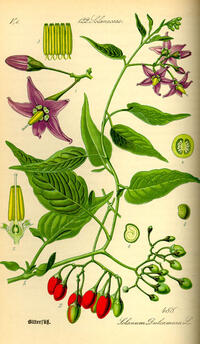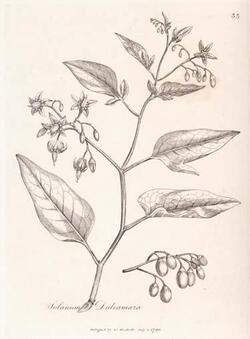This is an old revision of the document!
Brussels Plants
the information about plants which grows around the FoAM building/ Koolmijnenkaai 30-34
Solanum dulcamara
“—Description—It is a perennial, shrubby plant, quite woody at the base, but throws out long, straggling, slender branches, which trail over the hedges and bushes among which it grows, reaching many feet in length, when supported by other plants. They are at first green and hairy, but become woody and smooth as they grow older, with an ashygreen bark. The plant was called the Woody Nightshade by the old herbalists to distinguish it from the Deadly Nightshade. Its generic name Solanum is derived from Solor (I ease), and testifies to the medicinal power of this group of plants. The second name, Dulcamara, used to be more correctly written in the Middle Ages, Amaradulcis, signifying literally 'bittersweet,' the common country name of the plant, given to it in reference to the fact that the root and stem, if chewed, taste first bitter and then sweet. Another old name is Felonwood, probably a corruption of Felonwort, the plant for felons - felon being an old name for whitlow. We are told by an old writer that:'the Berries of Bittersweet stamped withrusty Bacon, applied to the Joynts of the Finger that is troubled with a Felon hath been found by divers country people who are most subject thereto to be very successful for the curing of the same.' Gerard says of it:'The juice is good for those that have fallen from high places, and have been thereby bruised or beaten, for it is thought to dissolve blood congealed or cluttered anywhere in the intrals and to heale the hurt places.' Boerhaave, the celebrated Dutch physician, considered the young shoots superior to Sarsaparilla as a restorative, and Linnaeus, who at first had an aversion to the plant, later spoke of it in the highest terms as a remedy for rheumatism, fever and inflammatory diseases of all kinds. There are few complaints for which it has not been at some time recommended.”
“—Medicinal Action and Uses— The drug possesses feeble narcotic properties, with the power of increasing the secretions, particularly those of the skin and kidneys. It has no action on the pupil of the eye. It is chiefly used as an alterative in skin diseases, being a popular remedy for obstinate skin eruptions, scrofula and ulcers. It has also been recommended in chronic bronchial catarrh, asthma and whoopingcough. For chronic rheumatism and for jaundice it has been much employed in the past, an infusion of 1 OZ. of the dried herb to 1/2 pint water being taken in wineglassful doses, two or three times daily. From the fluid extract made from the twigs, a decoction is prepared of 10 drachms in 2 pints of boiling water, boiled down to 1 pint, and taken in doses of 1/2 to 2 OZ. with an equal quantity of milk. The berries have proved poisonous to a certain degree to children. Fluid extract, 1/2 to 2 drachms.”
-Information source:- http://www.botanical.com/botanical/mgmh/n/nighwo06.html
as well as:


